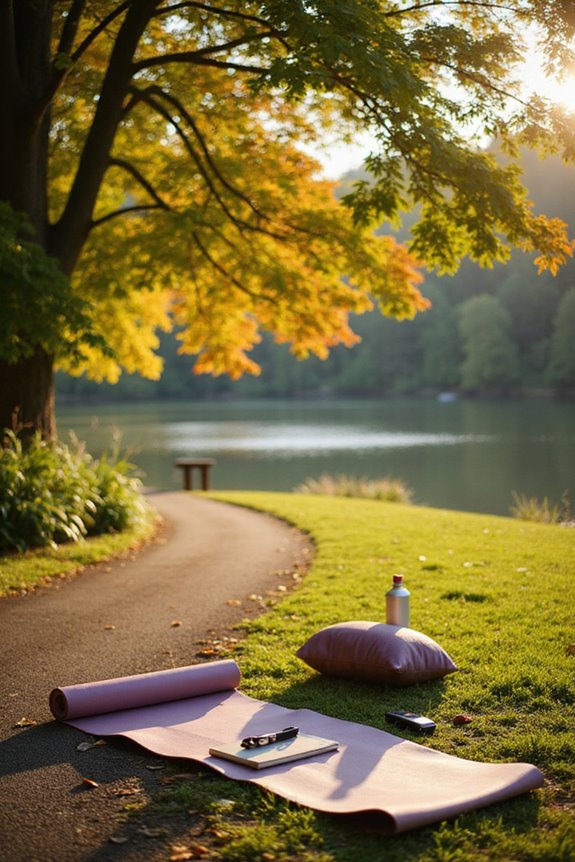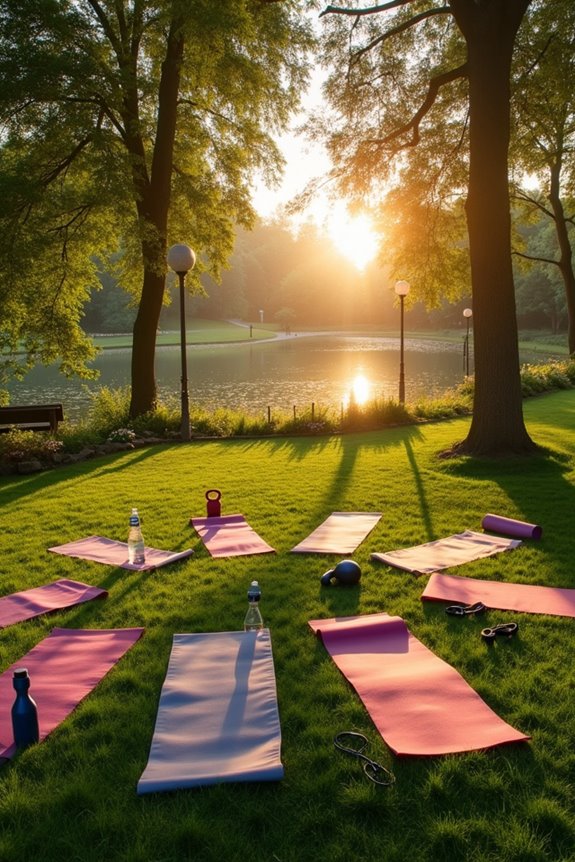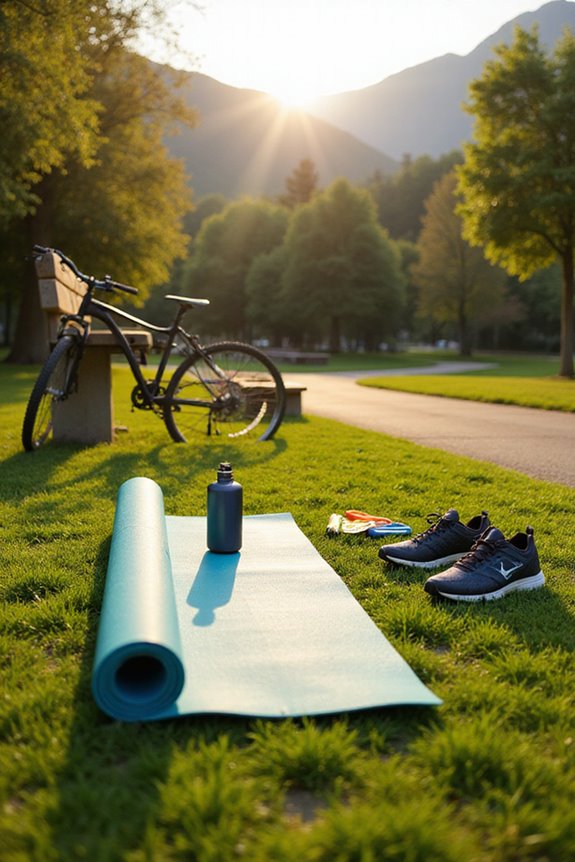Outdoor exercise has a ton of perks! It boosts physical health by improving heart fitness and bone density while helping with weight management. On the mental side, getting outside can lift spirits, reduce stress, and enhance self-esteem. Plus, the fresh air and natural light can seriously improve sleep too. With opportunities for social interaction and stunning scenery, outdoor workouts feel more like adventures. So, if you’re curious about how to make the most of this experience, there’s more to explore!
Key Takeaways
- Outdoor exercise boosts cardiovascular fitness, aiding in heart health and reducing disease risks.
- Engaging in nature lowers stress levels, enhancing mental well-being and emotional resilience.
- It encourages social interaction, fostering community connections and reducing feelings of isolation.
- Exercising outdoors promotes mindfulness and improves sleep quality through exposure to natural light.
- Diverse terrains aid in weight management, enhancing overall physical health and fitness levels.
Physical Health Benefits
When it comes to outdoor exercise, the physical health benefits truly shine, and it’s hard not to get excited about them. Engaging in outdoor activities like hiking or jogging can greatly boost cardiovascular fitness, reducing risks of heart disease. Those scenic trails aren’t just beautiful—they help manage weight too, with varying terrains upping the caloric burn. Plus, the fresh air and natural light can improve sleep quality, making those restless nights a thing of the past. Let’s not forget bone density; outdoor exercise enhances bone strength, especially important as we age. So, whether it’s a brisk walk or a vigorous mountain trek, outdoor workouts are a fantastic way to nurture both body and mind while enjoying nature’s masterpiece!
Psychological and Mental Health Benefits

Outdoor exercise doesn’t just pump up the heart and strengthen the bones; it also works wonders for the mind. Engaging in physical activity outside greatly reduces stress, with natural environments lowering cortisol levels and easing anxiety. Imagine a 90-minute stroll in the woods, where the calming sights and sounds buffer emotional turbulence—what a relief! Such experiences foster emotional resilience, allowing individuals to bounce back from life’s challenges. Plus, outdoor workouts boost self-esteem and enhance cognitive functions, like memory and creativity. By incorporating mindfulness practices, like focusing on the rustling leaves or the fresh air, the mental restoration becomes even richer. So, lace up those sneakers and step into nature—it’s a delightful way to nourish both body and mind!
Environmental and Motivational Benefits

While many may think of exercise as a chore, the great outdoors transforms this routine into an adventure waiting to unfold. Outdoor exercise allows for a rejuvenating nature connection, where parks and trails provide diverse backdrops that indoor gyms simply can’t match. Imagine running along a scenic path, the wind in your hair, and the hills challenging your stamina. Not only does outdoor accessibility make physical activity affordable for everyone, but it also encourages social interaction—think of all those spontaneous chats with fellow joggers! Plus, the vibrant surroundings boost motivation, making it easier to stick to a routine. Embracing the beauty of nature not only enhances enjoyment but also fosters a sense of responsibility towards preserving these precious environments for future adventurers.
Physiological Improvements

Step outside, and suddenly the world transforms into a vibrant playground for the body. Engaging in outdoor activities offers a treasure trove of physiological benefits that can greatly improve health. For instance, studies reveal that walking in nature can significantly lower blood pressure and enhance cardiovascular health more effectively than indoor workouts. Regular outdoor exercise boosts heart rate and increases VO2 max, paving the way for better aerobic fitness. Plus, it helps shed body fat and improves cholesterol levels, leading to healthier metabolism and weight management. With increased lung capacity and muscle strength, outdoor activities also enhance flexibility and bone density. So, why not lace up those sneakers and embrace the great outdoors? Your body will thank you!
Social and Community Benefits

When people gather in the great outdoors, something magical happens; connections spark and friendships bloom in ways that indoor settings often struggle to achieve. Outdoor group activities foster vibrant social interaction, allowing participants to bond through teamwork and shared challenges. In these relaxed natural environments, folks can share stories, resolve conflicts, and even enhance their leadership skills. Families engaging in outdoor adventures find their communication improves and their emotional bonds strengthen, contributing to a sense of belonging. Furthermore, repeated participation in community events creates a supportive network, combating loneliness and isolation. By embracing the outdoors together, communities not only promote healthy lifestyles but also cultivate a thriving atmosphere where camaraderie and trust flourish, enriching everyone’s emotional well-being.
Strategic Implementation and Promotion
Strategic implementation and promotion of outdoor fitness spaces can transform a community, making it not just a place for exercise, but a vibrant hub for social interaction and well-being. By focusing on community engagement, local input shapes these spaces, ensuring everyone’s needs are met. Infrastructure development plays an essential role—think accessible paths, safe locations, and proper lighting for evening workouts. Imagine families enjoying outdoor fitness classes or friends gathering for a morning yoga session in a park. Public awareness campaigns and social media can rally the community, while incentives like free classes make participation irresistible. Together, these strategies cultivate a lively atmosphere, encouraging an active lifestyle that benefits everyone in the neighborhood. Who wouldn’t want to be part of that?
Outdoor Exercise and Chronic Disease Prevention
Outdoor exercise, it turns out, is more than just a fun way to get moving; it plays an essential role in preventing chronic diseases. Engaging in outdoor activities helps reduce sedentary time, a known risk factor for chronic disease. With more time spent outdoors, individuals often get more moderate to vigorous physical activity, greatly lowering their chronic disease risk. Not only does outdoor exercise improve physical health, but it also enhances mental well-being by reducing stress and promoting social connections. Imagine strolling through a park or jogging on a trail—these moments not only boost fitness but also cut healthcare costs linked to chronic illnesses. Ultimately, the outdoor activity impact transcends mere exercise, fostering a healthier, happier lifestyle for everyone.
Enhancing Exercise Enjoyment Through Nature
As the sun peeks over the horizon and bathes the world in golden light, stepping outside can transform a mundane workout into an exhilarating adventure. Nature immersion offers a feast for the senses; the rustling leaves, chirping birds, and fresh air invigorate the body and mind. Engaging in activities like hiking, biking, or kayaking not only breaks the monotony but also makes exercise feel less like a chore. With lower perceived effort, participants often find themselves smiling as they sweat. The social interactions that naturally happen outdoors further enhance enjoyment, fostering connections that indoor gyms can’t replicate. Ultimately, the combination of beautiful surroundings and sensory experiences can elevate one’s mood, making fitness a joyful, fulfilling journey rather than a solitary struggle. Additionally, outdoor exercise often incorporates spacious designs that allow for group activities, enhancing social engagement and motivation.
Frequently Asked Questions
How Does Outdoor Exercise Affect Sleep Quality?
Outdoor exercise greatly influences sleep quality by enhancing sleep patterns through natural light exposure. This exposure helps regulate circadian rhythms, ultimately resulting in improved sleep onset, duration, and overall sleep maintenance for individuals engaging in regular activity.
Can Outdoor Exercise Improve Creativity Levels?
Research indicates that outdoor exercise can enhance creativity levels considerably, with participants experiencing a notable creativity boost. Immersion in nature fosters cognitive engagement, leading to improved problem-solving and innovative thinking, proving beneficial for creative endeavors.
What Types of Outdoor Activities Are Best for Beginners?
For beginners, hiking trails offer accessible exploration, while beginner yoga provides a gentle introduction to outdoor fitness. Both activities encourage gradual skill development and enhance confidence, making them ideal choices for those new to outdoor pursuits.
Is There a Difference in Calorie Burn Between Indoor and Outdoor Exercise?
In the vast landscape of fitness, a calorie comparison reveals that outdoor exercise environments often ignite a greater calorie burn, driven by wind resistance and varied terrains, surpassing the controlled settings found indoors.
How Can I Stay Motivated to Exercise Outdoors Year-Round?
To stay motivated for outdoor exercise year-round, individuals can employ seasonal strategies and motivation techniques, such as setting clear goals, mixing activities, scheduling workouts, and tracking progress while celebrating milestones to maintain engagement and consistency.





